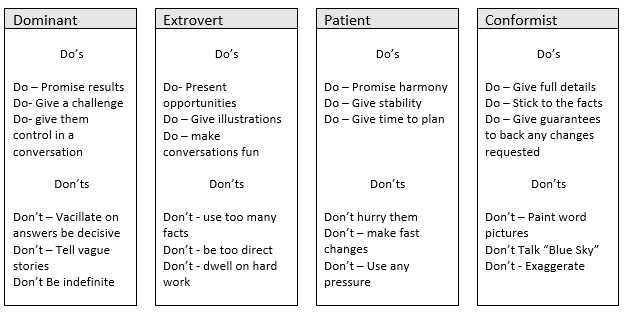In the third post about behaviours, within the Leadership series, we will look at how best to interact with each of the behaviours that we have discussed in the last two posts and to ensure we know what the “do’s” and “don’ts” are when communicating and working with each of the behavioural types.
The reality of life is that throughout our day we encounter many of the different behavioural types and equally they have to deal with our own behaviours. Where two or more people have to communicate there may need to be an adjustment in the method of communication to get the best out of the conversation. We may need to “flex” our own traits to match that of the other person. It does not mean changing what you want to say, just how you will say it. We may also need to adjust our pace of communication to match theirs.
Flexing our style
When dealing with a high Dominant you will need to get your point quickly, they generally do not have time, or patience, for messing around. They like discussions which can have measurable results at the end, or to discuss projects where they can see the potential for results. They have no patience for a rambling conversation and they get frustrated when a person cannot come to a decision and is mithering. They like you to be on time and show a good level of energy and enthusiasm for your subject.
When dealing with the high Extrovert you must allow time to socialise and they thrive on small talk and fun conversations. They do need a fast pace to the conversation, as they find it hard to be patient enough to wait for an answer that does not come immediately. Trust is very important, so you will need to have good eye contact with them, so they can judge if the body language matches what you are saying. They always love it if you can discuss people they know, or someone important that you know.
A relaxed pace is needing when interacting with a high Patient. You should never try to exert any pressure on them as they need time to make their own decision or you may get a no, which is easier. You may also have to encourage them to speak, it is good to use questions, and you must not use a harsh tone, or they could go quiet. They don’t really enjoy small talk unless it is genuine. They do, however, thrive in an atmosphere that is harmonious and friendly.
When speaking with a high Conformist you should be prepared and as a result can get down to business quickly. Where appropriate you should use as many facts and factual data as possible. You may find that you need to encourage them to make a decision, as they can be indecisive, so offering alternatives or using Pro/Con lists are excellent for this. They like conversations where you can set action plans in place with clear milestones, and with scheduled follow up.
Do’s and Don’ts
The chart below gives specific “Do’s and “Don’ts” for each of the behavioural traits.

In summary
To sum up the last three posts:
If you are dealing with a high Dominant say whatever you are going to say with certainty, be forceful and above all don’t waste their time. They are motivated by daily challenges and opportunities for growth, and they like communication to be quick and determined.
If dealing with a high Extrovert, then the conversation should have flair and be very encouraging to them. They are motivated by people interaction and like working in a team. They are quick and instinctive and enjoy it when you come across as persuasive and fun.
With the high Patience you need to use a tone of warmth and be very affable. Avoid causing friction. They are motivated when they have time to plan and are in a cooperative work environment. Take time to instil dependability, showing your sincerity.
Having prepared as much as possible in advance of your meeting with a high Conformist you need to speak in a precise and accurate way. Avoid any semblance of disorganisation. Keep to proven facts and systems. They are motivated by being able to work in a paced and methodical way, that is very disciplined, and you should try to be specific and detailed and as factual as possible when interacting with them.
To read from the beginning of the series click here
To read the next part in the series click here

